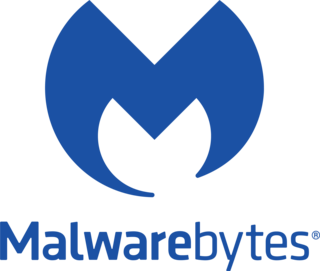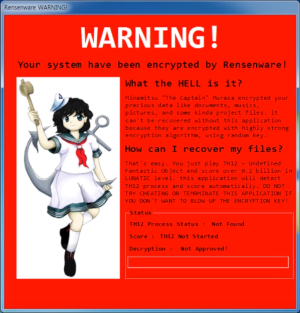Malware is any software intentionally designed to cause disruption to a computer, server, client, or computer network, leak private information, gain unauthorized access to information or systems, deprive access to information, or which unknowingly interferes with the user's computer security and privacy. Researchers tend to classify malware into one or more sub-types.
A key generator (key-gen) is a computer program that generates a product licensing key, such as a serial number, necessary to activate for use of a software application. Keygens may be legitimately distributed by software manufacturers for licensing software in commercial environments where software has been licensed in bulk for an entire site or enterprise, or they may be developed and distributed illegitimately in circumstances of copyright infringement or software piracy.
In computing, polymorphic code is code that uses a polymorphic engine to mutate while keeping the original algorithm intact - that is, the code changes itself every time it runs, but the function of the code will not change at all. For example, the simple math expressions 3+1 and 6-2 both achieve the same result, yet run with different machine code in a CPU. This technique is sometimes used by computer viruses, shellcodes and computer worms to hide their presence.

Antivirus software, also known as anti-malware, is a computer program used to prevent, detect, and remove malware.
Ransomware is a type of cryptovirological malware that permanently block access to the victim's personal data unless a ransom is paid. While some simple ransomware may lock the system without damaging any files, more advanced malware uses a technique called cryptoviral extortion. It encrypts the victim's files, making them inaccessible, and demands a ransom payment to decrypt them. In a properly implemented cryptoviral extortion attack, recovering the files without the decryption key is an intractable problem, and difficult to trace digital currencies such as paysafecard or Bitcoin and other cryptocurrencies are used for the ransoms, making tracing and prosecuting the perpetrators difficult.
Rogue security software is a form of malicious software and internet fraud that misleads users into believing there is a virus on their computer and aims to convince them to pay for a fake malware removal tool that actually installs malware on their computer. It is a form of scareware that manipulates users through fear, and a form of ransomware. Rogue security software has been a serious security threat in desktop computing since 2008. An early example that gained infamy was SpySheriff and its clones, such as Nava Shield.
File binders are utility software that allow a user to "bind" multiple files together, resulting in a single executable. They are commonly used by hackers to insert other programs such as Trojan horses into otherwise harmless files, making them more difficult to detect. Malware builders often include a binder by default.

CCleaner, developed by Piriform Software, is a utility used to clean potentially unwanted files and invalid Windows Registry entries from a computer. It is one of the longest-established system cleaners, first launched in 2004. It was originally developed for Microsoft Windows only, but in 2012, a macOS version was released. An Android version was released in 2014.

VirusTotal is a website created by the Spanish security company Hispasec Sistemas. Launched in June 2004, it was acquired by Google in September 2012. The company's ownership switched in January 2018 to Chronicle, a subsidiary of Google.

A computer virus is a type of malware that, when executed, replicates itself by modifying other computer programs and inserting its own code into those programs. If this replication succeeds, the affected areas are then said to be "infected" with a computer virus, a metaphor derived from biological viruses.

Malwarebytes is an anti-malware software for Microsoft Windows, macOS, ChromeOS, Android, and iOS that finds and removes malware. Made by Malwarebytes Corporation, it was first released in January 2006. It is available in a free version, which scans for and removes malware when started manually, and a paid version, which additionally provides scheduled scans, real-time protection and a flash-memory scanner.
Duqu is a collection of computer malware discovered on 1 September 2011, thought by Kaspersky Labs to be related to the Stuxnet worm and to have been created by Unit 8200. Duqu has exploited Microsoft Windows's zero-day vulnerability. The Laboratory of Cryptography and System Security of the Budapest University of Technology and Economics in Hungary discovered the threat, analysed the malware, and wrote a 60-page report naming the threat Duqu. Duqu got its name from the prefix "~DQ" it gives to the names of files it creates.
Sality is the classification for a family of malicious software (malware), which infects Microsoft Windows systems files. Sality was first discovered in 2003 and has advanced to become a dynamic, enduring and full-featured form of malicious code. Systems infected with Sality may communicate over a peer-to-peer (P2P) network to form a botnet to relay spam, proxying of communications, exfiltrating sensitive data, compromising web servers and/or coordinating distributed computing tasks to process intensive tasks. Since 2010, certain variants of Sality have also incorporated rootkit functions as part of an ongoing evolution of the malware family. Because of its continued development and capabilities, Sality is considered one of the most complex and formidable forms of malware to date.
The Blackhole exploit kit was, as of 2012, the most prevalent web threat, where 29% of all web threats detected by Sophos and 91% by AVG are due to this exploit kit. Its purpose is to deliver a malicious payload to a victim's computer. According to Trend Micro the majority of infections due to this exploit kit were done in a series of high volume spam runs. The kit incorporates tracking mechanisms so that people maintaining the kit know considerable information about the victims arriving at the kit's landing page. The information tracked includes the victim's country, operating system, browser and which piece of software on the victim's computer was exploited. These details are shown in the kit's user interface.
Slenfbot is the classification for a family of malicious software (malware), which infects files on Microsoft Windows systems. Slenfbot was first discovered in 2007 and, since then, numerous variants have followed; each with slightly different characteristics and new additions to the worm's payload, such as the ability to provide the attacker with unauthorized access to the compromised host. Slenfbot primarily spreads by luring users to follow links to websites, which contain a malicious payload. Slenfbot propagates via instant messaging applications, removable drives and/or the local network via network shares. The code for Slenfbot appears to be closely managed, which may provide attribution to a single group and/or indicate that a large portion of the code is shared amongst multiple groups. The inclusion of other malware families and variants as well as its own continuous evolution, makes Slenfbot a highly effective downloader with a propensity to cause even more damage to compromised systems.
The CryptoLocker ransomware attack was a cyberattack using the CryptoLocker ransomware that occurred from 5 September 2013 to late May 2014. The attack utilized a trojan that targeted computers running Microsoft Windows, and was believed to have first been posted to the Internet on 5 September 2013. It propagated via infected email attachments, and via an existing Gameover ZeuS botnet. When activated, the malware encrypted certain types of files stored on local and mounted network drives using RSA public-key cryptography, with the private key stored only on the malware's control servers. The malware then displayed a message which offered to decrypt the data if a payment was made by a stated deadline, and it threatened to delete the private key if the deadline passes. If the deadline was not met, the malware offered to decrypt data via an online service provided by the malware's operators, for a significantly higher price in bitcoin. There was no guarantee that payment would release the encrypted content.
Malware analysis is the study or process of determining the functionality, origin and potential impact of a given malware sample such as a virus, worm, trojan horse, rootkit, or backdoor. Malware or malicious software is any computer software intended to harm the host operating system or to steal sensitive data from users, organizations or companies. Malware may include software that gathers user information without permission.
Dridex, also known as Bugat and Cridex, is a form of malware that specializes in stealing bank credentials via a system that utilizes macros from Microsoft Word.
Joanap is a remote access tool that is a type of malware used by the government of North Korea. It is two-stage malware, meaning it is "dropped" by another software. Joanap establishes peer-to-peer communications and is used to manage botnets that can enable other operations. On Windows devices that have been compromised it allows data exfiltration, to drop and run secondary payloads, initialization of proxy communications, file management, process management, creation/deletion of directories, and node management.

Rensenware is ransomware that infects Windows computers. It was created as a joke by Kangjun Heo and first appeared in 2017. Rensenware is unusual as an example of ransomware in that it does not request the user pay the creator of the virus to decrypt their files, instead requiring the user to achieve a required number of points in the bullet hell game Touhou Seirensen ~ Undefined Fantastic Object before any decryption can take place. The main window displays Minamitsu Murasa, a character from the game. Heo released a patch that neutralizes Rensenware after accidentally infecting himself with it.






